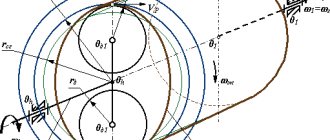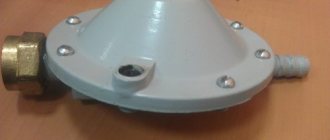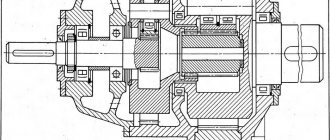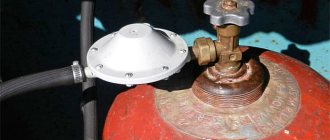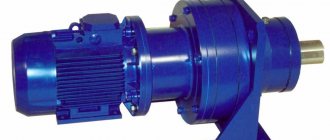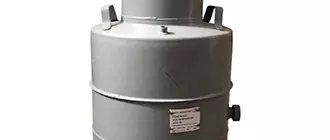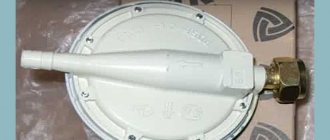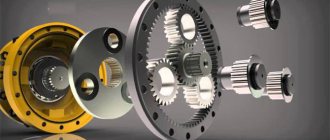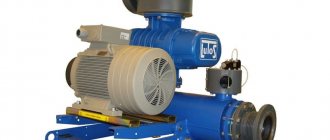1 / 1
We will not go into the jungle of theoretical reflections; we note that the word “reducer” comes from the word “reduce”. It is translated into Russian as “change in the direction of weakening.” It logically follows from this that the oxygen reducer is a device for reducing gas pressure.
How does it work?
Gas is pumped into cylinders under high pressure or liquefied so that as much of it as possible fits into the container. For welding and other purposes, propane is needed at much lower pressure, supplied at a constant rate. For this purpose, a reducer is placed on the cylinder .
It lowers the pressure to working pressure and ensures its uniform supply. In the chamber, inside the housing, there is a membrane, adjustable with a screw. It is pressed on one side by the gas coming from the cylinder. When the membrane is displaced under gas pressure, a passage opens into the second part of the chamber, where operating pressure is created.
All gas reducers have a reduction-reducing operating principle. When the pressure inside the container drops to working pressure, work stops.
Based on the operating principle of the membrane, a distinction is made between direct and reverse reduction methods.
Straight
With direct reduction, gas from the cylinder enters the first chamber and presses the membrane . Through the resulting gap, propane passes into the working space of the gearbox. When the required pressure is created in it, the membrane is installed in place and blocks the flow of gas. Propane leaves the working chamber, the pressure decreases, and again the gas from the cylinder opens the entrance. Gradually, equilibrium is established and a constant gap remains between the chambers.
Back
During reverse reduction, the membrane is initially open and gas from the cylinder freely flows into the working half of the chamber . After reaching the desired pressure, he presses the membrane and closes it.
On gas reducers for liquefied propane cylinders, the reverse reduction method is generally installed. It provides a stable gas supply at a uniform speed. Setting the required pressure on this design is easier and faster.
Carbon dioxide reducers for semi-automatic machines use direct reduction. The pressure decreases mainly due to the difference in the sizes of the chambers. There is only one pressure gauge on such devices. It shows the outlet pressure. The adjustment occurs by changing the size of the transfer channel.
The oxygen reducer for an oxygen cylinder has two pressure gauges or a rotameter instead of the second one installed at the outlet . They show the pressure in the cylinder and the rate of consumption or pressure in the working chamber.
Oxygen reducer device
The design and operating procedure of the gearbox is best viewed in the figure (see below). Let's consider the operation of a reverse-action gearbox, as the most common. Oxygen flows from the cylinder into inlet 1.
The adjusting screw 9 is screwed in, the setting spring 10 is compressed and with its force it lifts the membrane 11 up. The membrane with its pusher 12 opens the valve, overcoming the force of the upper spring 3. Gas begins to flow into chamber 8 and into the outlet fitting.
As soon as the gas pressure in chamber 8 exceeds that set by the control screws, membrane 11 will bend down and pusher 12 will close the valve. Gas continuing to escape through the outlet fitting will lead to a decrease in pressure in the chamber, and the cycle will repeat again. The adjusting screw has a fine thread, which allows you to very accurately set the operating pressure. To control the pressure, pressure gauges are installed at input 2 and output 7 of the reducer.
To avoid an emergency increase in pressure in the chamber, a safety valve 6 is installed on it, which “bleeds” excess pressure into the atmosphere. The figure is presented in a simplified form for a better understanding of the process. In a real device, several filters of various designs are also installed to purify the gas.
Classification depending on the scope of application
Gas equipment running on propane differs in operating pressure and the need to regulate flow. Gearboxes are divided according to the principle of use:
- unregulated household;
- adjustable universal;
- industrial professional.
Each group is designed for a specific consumable equipment and intensity of use.
Household unregulated
Household equipment: furnaces, boilers, car engines and others are configured to work with constant pressure .
There is no need to adjust the gas flow per minute. Household pressure reducing equipment is adjusted to the required parameters at the enterprise and the outlet pressure is indicated on the housing cover next to the date of manufacture. Only 2 pipes come out of the housing for connection to the cylinder and working equipment that consumes household gas. There is no regulator or pressure gauge. It does not have instruments indicating pressure and flow, a methane reducer on the car. Household reducers are designed for low flow and low outlet pressure . They have a simple device that allows you to repair them yourself.
Universal adjustable
The propane adjustable adapter is similar in design to the carbon dioxide reducer for a semi-automatic machine.
It has one pressure gauge showing the pressure in the working chamber and an adjusting screw. Universal gearbox suitable for household and medical equipment . It will serve well for amateurs who use welding periodically in small quantities. You don’t have to think long about which budget gearbox to buy if you use a gas gun for short-term heating.
Professional
Externally, professional propane reducers are distinguished by the presence of two pressure gauges and a side hole, closed with a plug, used for cleaning the channel. The adjusting screw is located at the top. Suitable for connection to a semi-automatic welding machine, gas torch and other industrial equipment operating in active mode.
The device differs from the universal one in its increased strength. The body, gaskets, and parts are made of expensive and wear-resistant materials.
Setting up the oxygen reducer
Similar actions must be carried out when preparing a newly installed oxygen reducer for operation. The first step is to make sure that the pressure gauges located on the gearbox are in good working order. The pressure gauge arrows must strictly point to “0” and not move when turning and moving the gearbox.
Before attaching the hose to the cylinder fitting, you must ensure that the adjusting screw rotates smoothly. Fully unscrewing the screw ensures that the oxygen supply stops.
It would not be superfluous to make sure that the entire assembly is tight. To do this, you need to connect the burner, open the oxygen supply to it, set the operating pressure with the adjusting screw and coat all joints with soapy water. The absence of soap bubbles will indicate their tightness.
After all the above measures, wipe the gearbox and once again visually check for stains that may be oils or fats. In suspicious cases, it is better to wipe everything with solvent again. Now you can start the test run.
Features of using composite containers
The container of the composite cylinder is made of fiberglass impregnated with epoxy glue - resin plus hardener . The material is highly durable and is not afraid of dynamic loads. At the same time, it is good and easy to transport. A 20 liter propane cylinder weighs only 7 kg.
The plastic casing on top protects the container from impacts and damage. The slots allow you to see the translucent base and the level of liquefied gas and determine the quantity. Composite cylinders have advantages over metal cylinders:
- no static stress is formed on the surface of the materials;
- the weight of the container is 2 times less;
- special handles in the outer shell make transportation convenient;
- upon impact, only the plastic casing can burst, the fiberglass cylinder is reliably protected;
- do not explode when heated to 100⁰;
- have a fuse-link - fuse against overheating;
- safe.
During transportation and storage, composite gas cylinders can be stacked on top of each other. The operating temperature range is significantly greater than that of metal analogues, from – 40⁰ to +60⁰ .
Composite cylinders have Euro connectors. The gearboxes are connected via adapters.
Medical oxygen reducer
Unlike gearboxes for gas cutting, medical gearboxes are produced only of direct action, with the tap position “up”. They are much smaller in size and, accordingly, lighter. In addition, it is connected to the cylinder using both a union nut and a gasket. Gas enters either through the nipple or, if there is none, through the valve. If this is a device for a gas mixture of nitrogen and oxygen, an electric gas heater is also used in the design. The flow of oxygen or nitrous oxide occurs more smoothly, due to the design, and can produce a pressure of 25 l/minute, in cases of use in intensive care, and 7 l/minute to facilitate the breathing of a patient in a ward or a special room.
Medical gearboxes are manufactured in accordance with TU -84-379; they must not have aluminum parts that could lead to ignition of the device if adiabatic compression exceeds the norm.
Therefore, these devices cannot be interchangeable.
What does it represent?
The reduction mechanism, depending on its purpose, has a body painted red . It has the inscription “Propane” in paint. Unregulated devices have a convex body from which 2 pipes emerge for connection to the cylinder and hose of the working mechanism.
The gas reducer with a pressure regulator for propane has a valve, 1 or 2 pressure gauges, depending on the purpose . On semi-professional devices, the device shows gas flow and sets the pressure based on it. Professional models are chosen for welding machines. Using instruments, you can determine not only the gas supply speed, but also the pressure in the cylinder.
Kinds
Depending on the installation location, they distinguish between BKO and BKD cylinder reducers, which means single-stage cylinder oxygen and two-stage cylinder oxygen with mechanical pressure regulation. To ensure welding, the BKO 50 - 4 reducer is most often used. The marking indicates the device’s ability to pass 50 m3/hour of gas at a pressure of 4 atm.
When powering welding stations from the gas main, SKO network reducers are used. They are used in cases where the gas pressure in the network exceeds the pressure acceptable for consumers. A distinctive feature is the presence of only one pressure gauge, which shows the gas pressure at the outlet of the device.
Centralized gas supply, carried out at high pressure, requires the installation of ramp reducers (RKZ). Their distinctive feature is their large throughput capacity up to 125 m3/hour. They are installed on the high pressure rail directly on the pipeline. Can be operated at oxygen pressures up to 300 bar. They have a built-in inlet filter and a valve to relieve excess pressure.
There are two types of oxygen reducers, differing in operating principles: direct action and reverse action. We will look at the features of their work below. For those who do not want to delve into the intricacies of the operation of these devices, we note that reverse-action reducers are considered more reliable, have a simpler design and allow you to maintain normal operating pressure until the gas in the cylinder runs out.
How to choose for home use?
In everyday life, propane is widely used for cooking, heating rooms and in cars instead of gasoline. All equipment is created under constant gas pressure. Household reducers for propane cylinders are not regulated .
They have a membrane installed at a specified pressure during manufacture. Household reducers have 3 gas flow rates: 50, 37 and 30 mbar. To determine the pressure at which the stove or other equipment operates, you should look at the technical data sheet. The adapter is marked on the cover, where, in addition to the pressure output, the date of manufacture and testing is indicated, and there is a manufacturer's stamp.
When installing gas equipment yourself, you should select a frog reducer for a gas cylinder based on the operating value of the gas pressure of the stove or boiler and flow rate . The reduction model got its name from the slightly convex shape of the round body, which gives it a resemblance to amphibians.
A universal adjustable adapter designed for propane can be installed on household equipment. It should be selected according to the pressure or gas flow rate at the outlet. If the equipment is designed for a higher flow rate, it will interrupt operation and the flame will constantly go out.
The reducer for the carbon dioxide cylinder has a different design and is not suitable for long-term operation. Its parts, including gaskets, are made of material that breaks down upon contact with propane.
What is a gearbox, and what types of gearboxes are there?
The gearbox is designed to reduce the received power, pressure or number of revolutions to the required value that is necessary for the operation of the equipment. These can be gearboxes for the drive wheels of a car, a gearbox for an electric drill or screwdriver, a gas reducer or an oxygen reducer. Gearboxes have different designs, but perform their task, which comes from the name of the device. To reduce means to lower.
Drive axle gearbox in a car
By design, it can consist of bevel, cylindrical gears, it can consist of a worm and a wheel, it can have a central gear, carrier and satellites, which are located around the central sun gear, it can have two high and low pressure chambers and a membrane between them.
Planetary gearbox, standard design
Design features and maintenance
There are 2 types of gases used in industry and everyday life:
- inert;
- flammable.
The adapters on them are fundamentally different, so as not to confuse them . For inert gas cylinders, the connection between the reducer and the cylinder is made with a right-handed, standard thread. Oxygen, propane, carbon dioxide, methane and other flammable gases are connected to the reducer by screwing it into a hole with a left-hand thread - counterclockwise.
Multi-directional threads eliminate the possibility of filling the container with the wrong type of gas and using the cylinder for purposes other than its intended purpose.
Gearboxes have a membrane inside that wears out. The gearbox must be tested every 5 years. In this case, the membrane is replaced with a new one . In reducers for composite cylinders - made according to European standards, the membrane is designed to operate for at least 10 years, but the equipment must be tested after 5 years.
There is a marking on the top of the case indicating the year of manufacture of the unit and the first verification. During the subsequent test, the next date is entered.
The gearbox must be lubricated regularly and checked for leaks. If necessary, the gaskets must be changed.
Instructor, college teacher at the Donmet plant Sarkizov P.V.: “There is an opinion among amateurs that a gearbox with a rotameter allows you to use gas economically. In practice, the devices differ only in their readings. The second pressure gauge on the reducer shows gas flow per minute. This value is inherent in the welding modes. The rotameter shows the actual pressure in the working chamber at the moment. To set operating parameters, you need to recalculate the rotameter readings using a coefficient or use a conversion table.
Gearboxes with 2 rotameters are designed for welding refractory metals and with high heat transfer. A welding torch is connected to the first, and a nozzle for heating the back side of the seam is connected to the second. You cannot connect 2 devices."
Characteristics and Features
For the correct selection and trouble-free operation of the gearbox, you need to know its purpose and characteristics. Manufacturers and trading organizations accompany their products with the following set of characteristics:
- type of gearbox (reverse or direct acting);
- number of steps;
- throughput;
- working pressure value;
- maximum inlet pressure;
- Climatic performance.
When describing the device, we focused on a reverse-action gearbox. This is due to the fact that this type is found everywhere and has decisive advantages over the direct-acting reducer in the form of reliability and conditions for using gas from a cylinder. A detailed description of the operation of a direct-acting gearbox may be of interest only to highly specialized specialists. For most users, it is enough to know that the difference between them is that in a direct-acting reducer the gas pressure from the cylinder tends to open the valve, while in a reverse-acting reducer it tends to close it.
Gearboxes come in single-stage and two-stage types. Single-stage ones are most widespread. They are simpler in design and, accordingly, cheaper. Two-stage ones are more complex and expensive, but there are cases when you can’t do without them. The presence of intermediate chambers in a two-stage reducer prevents the possibility of freezing of the reducer when operating with high gas flow rates at low temperatures. They allow operation at subzero temperatures and pressures up to 200 atmospheres.
Characteristics such as throughput, operating pressure and maximum inlet pressure are intuitively understandable and do not require special explanation. Climatic design takes into account the characteristics of work in various climatic zones (heat, cold, dampness, humidity, etc.).
Precautionary measures
Propane and other cylinder gases are flammable and can explode if not handled correctly . Propane is odorless, but at a concentration of 3% in the air, it causes poisoning. It is necessary to select the equipment correctly and monitor its serviceability. The room should be constantly ventilated.
The reducer must be suitable for the gas for which it is manufactured. You can select an oxygen unit and place it on a carbon dioxide cylinder. But it’s not the other way around, especially if welding is carried out in intensive mode. Parts will quickly fail, since the material is not designed for contact with oxygen, cools down and collapses.
As oxygen evaporates, it cools and freezes. The reducer for the oxygen cylinder must be heated. It is optimal to use a flow-through heater . It warms the gas stream at the inlet to the reducer. At the same time, the node itself remains cold. Using an oxygen adapter without heating leads to cooling of parts to -60⁰ and rapid destruction of gaskets. The result is gas leakage and leakage.
Methane and propane reducers have the same color - red, but completely different designs. They are not interchangeable .
Causes of gearbox failures
Like any technical device, the oxygen reducer is susceptible to problems that arise during operation. Thus, oxygen leakage may occur due to the fact that the seal between the valve and the chambers is broken. This may be because the hard rubber seat seal has worn out, or because foreign particles have entered the valve mechanism.
When operating in winter, the oxygen reducer may freeze. To prevent this phenomenon, the valve of the cylinder must be closed and blown with warm air. This will remove both ice and excess moisture. By the way, it is strictly prohibited to use fire to heat the gearbox.
There are frequent cases when the gearbox becomes clogged with foreign particles. To prevent this, the filter must be periodically blown or washed.
Periodic inspection and service work
The instructions for gas equipment require that the verifications specified in the passport be carried out regularly, even if welding and other work is carried out periodically.
Once a quarter the gearbox is purged - safety valve test . Equipment requires service once every six months. The membrane is checked and replaced every 5 years. Every day, before work, you should check the tightness of all connections. Apply soapy water to all joints.
Where to buy an oxygen reducer
You can get rid of many surprises and troubles when operating a gearbox at the stage of purchasing it. To do this, you need to choose a time-tested manufacturer. The group is a reliable manufacturer and supplier of welding equipment in Russia, Europe and Asia.
On our website you can familiarize yourself with the characteristics, get detailed advice and buy a reducer for an oxygen cylinder BKO-50-4M in a climatic version from -25°C to +50°C and a reducer for reducing gas pressure BKO-50 for operation in the temperature range from -15° to +15° С.
Area of application of devices
Propane and reducers for cylinders are widely used in various industries and households:
- welding;
- household stoves for cooking;
- heating of utility rooms;
- fuel for cars;
- on construction.
Light propane cylinders are taken with you into the wild and fried meat by connecting a burner to them.
The propane reducer provides a stable flow of gas at a given pressure. Using a cylinder without reducing equipment will result in an accident. The reducer should be selected exactly in accordance with the requirements of the gas-consuming equipment.

